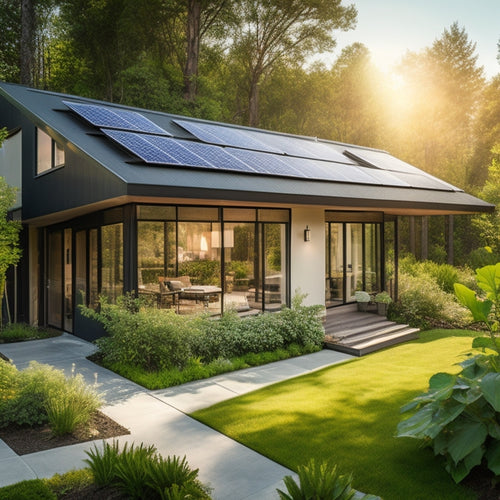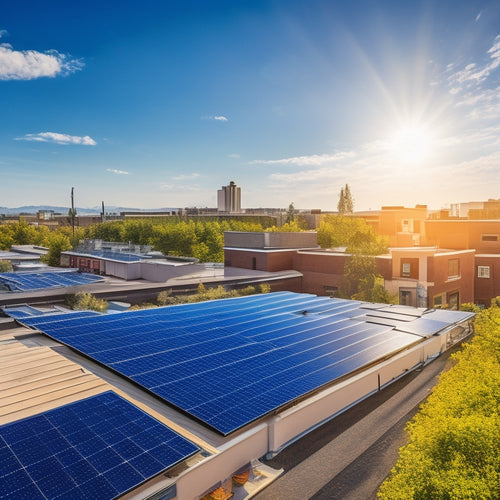Why Are Solar Panel Prices Dropping So Fast?
Share
You're benefiting from a dramatic 70% drop in solar panel costs over the past decade, driven by a combination of factors. Manufacturing efficiencies have reduced production costs, while advancements in technology have boosted efficiency. Economies of scale, increased competition, and falling raw material costs have also contributed to the decline. Government incentives and subsidies have made solar energy more accessible. Now, as you explore solar energy options, you're likely wondering what other factors are driving these price drops - and what it means for your investment.
Key Takeaways
• Dramatic reductions in manufacturing costs, up to 70%, have been achieved through streamlined supply chains and optimized production processes.
• Advancements in solar panel technology, such as nanostructures and bifacial designs, have boosted efficiency and reduced costs.
• Economies of scale in production have spread fixed costs, reducing production costs per unit, and intensified competition among manufacturers.
• Falling raw material costs, particularly silicon, have significantly contributed to plummeting solar panel prices.
• Government incentives and subsidies have reduced upfront costs, increased adoption rates, and encouraged the use of renewable energy grants.
Dramatic Decrease in Manufacturing Costs
As solar panel manufacturers have scaled up production and implemented more efficient manufacturing processes, they've been able to slash their costs by as much as 70% over the past decade. You might wonder how they've achieved such a dramatic decrease in manufacturing costs. The answer lies in their ability to streamline their supply chain and optimize their production processes. By reducing waste, improving yields, and implementing more efficient equipment, manufacturers have been able to greatly lower their costs per unit.
Importance analysis has played a vital role in identifying areas for improvement and tracking the effectiveness of these efforts. By analyzing their costs and identifying areas of inefficiency, manufacturers have been able to target their efforts and make data-driven decisions.
The result has been a steady decline in the cost of solar panels, making them more competitive with fossil fuels and increasing their adoption around the world. As manufacturers continue to refine their processes and implement new technologies, it's likely that costs will continue to fall, making solar energy an increasingly viable option for consumers.
Advancements in Solar Panel Technology
Researchers have made significant strides in boosting solar panel efficiency by developing innovative materials and designs that harness more energy from the sun. You're likely aware that traditional solar panels convert only a fraction of the sun's energy into electricity. However, advancements in technology have changed the game. For instance, the integration of nanostructures and quantum dots has led to a substantial increase in energy absorption.
| Technology | Efficiency Improvement |
|---|---|
| Nanostructures | 10-15% |
| Quantum Dots | 8-12% |
| Bifacial Designs | 5-7% |
| Thin-Film Materials | 3-5% |
| Advanced Anti-Reflective Coatings | 2-3% |
These advancements have led to a significant increase in solar panel efficiency, resulting in more electricity generated per unit area. As you explore the world of solar energy, it's essential to stay updated on the latest technological advancements. By leveraging these innovations, you can maximize your energy output and reduce your reliance on fossil fuels.
Economies of Scale in Production
As you explore the factors driving down solar panel prices, you'll notice that economies of scale in production play a significant role. By increasing manufacturing capacity, companies can spread their fixed costs over a larger output, resulting in lower production costs per unit.
This, in turn, enables them to offer solar panels at more competitive prices, making renewable energy more accessible to consumers.
Manufacturing Capacity Growth
By increasing production volumes, manufacturers have been able to reduce costs and take advantage of economies of scale, driving down the average cost per watt of solar panels. As you scale up production, you can spread fixed costs over a larger output, reducing the cost per unit. This is particularly important in the solar industry, where high upfront investments in equipment and facilities are necessary.
| Capacity Planning Strategy | Benefits |
|---|---|
| Increase production volumes | Reduce costs per unit |
| Optimize supply chain | Improve logistics and reduce transportation costs |
| Implement efficient manufacturing processes | Decrease production time and increase output |
| Invest in automation | Reduce labor costs and improve product quality |
| Expand production facilities | Increase capacity and reduce costs per unit |
Lower Production Costs
You can slash production costs dramatically when you manufacture on a large scale, thanks to the economies of scale in production. As the solar industry expands, manufacturers can take advantage of bulk purchasing, reducing the cost of raw materials and components. This, in turn, leads to lower production costs per unit.
A thorough cost analysis reveals that large-scale production enables companies to spread their fixed costs over a larger output, resulting in significant savings.
Moreover, a streamlined supply chain also contributes to reduced expenses. With higher production volumes, manufacturers can negotiate better deals with suppliers, further decreasing costs. As the industry grows, companies can invest in more efficient production technologies, leading to additional cost savings.
Increased Competition in the Market
More than 500 solar panel manufacturers are currently operating in the global market, intensifying competition and driving prices downward. You're likely aware that market trends are shifting, and this surge in manufacturers has led to a crowded market. Industry leaders, in particular, are feeling the pressure to stay competitive. As a result, they're slashing prices to maintain market share.
You'll notice that companies like Trina Solar, Jinko Solar, and Canadian Solar are consistently reducing their prices to stay ahead of the competition.
This increased competition has also led to improved efficiency in manufacturing processes. You'll find that companies are streamlining production, reducing waste, and optimizing supply chains to minimize costs. These cost savings are then passed on to you, the consumer, in the form of lower prices.
The downward pressure on prices is further exacerbated by the fact that new entrants are disrupting traditional market dynamics. As you navigate the solar panel market, you'll find that prices are becoming increasingly competitive, making solar energy a more viable option for you.
Falling Cost of Raw Materials
As you investigate the factors driving the plummeting cost of solar panels, you'll find that the falling cost of raw materials plays an important role. Silicon, a key component in solar panels, has seen a significant decline in price over the past few years, contributing heavily to the downward trend in solar panel costs.
This drop in silicon prices can be attributed to improved material sourcing and supply chain optimization. Manufacturers have optimized their supply chains to reduce waste and increase efficiency, resulting in lower costs. Additionally, advancements in material sourcing have enabled companies to procure high-quality silicon at a lower cost.
This reduction in raw material costs has had a direct impact on the overall cost of solar panels, making them more affordable for consumers. As you explore the solar panel market, you'll notice that companies are continually seeking ways to reduce costs without compromising quality, and the falling cost of raw materials is an important aspect of this effort.
Improved Manufacturing Efficiency Gains
Manufacturers' relentless pursuit of efficiency has led to significant improvements in the production process, driving down costs and further reducing the price of solar panels.
You've likely experienced the benefits of process innovations, which have streamlined manufacturing and reduced waste. By implementing cutting-edge technologies and optimizing production workflows, manufacturers can produce high-quality solar panels at a lower cost.
Supply chain optimization has also played an essential role in reducing costs. By streamlining logistics, manufacturers can reduce transportation costs, negotiate better prices with suppliers, and minimize inventory holding costs. As a result, the cost savings are passed on to you, the consumer.
Improved manufacturing efficiency gains have been instrumental in driving down solar panel prices, making renewable energy more accessible to a wider audience. As manufacturers continue to refine their production processes, you can expect even more competitive pricing in the future.
Government Incentives and Subsidies
As you explore the factors contributing to the decline in solar panel prices, you'll find that government incentives and subsidies have played a significant role.
You've likely benefited from tax credits, which have boosted adoption rates by making solar energy more affordable.
Now, let's examine how renewable energy grants have further accelerated the industry's growth.
Tax Credits Boost Adoption
Government-backed incentives, such as the Solar Investment Tax Credit (ITC), have been instrumental in driving down solar panel prices by offsetting up to 30% of the total project cost, making solar energy a more viable option for you. These Federal Incentives have played a vital role in boosting adoption, encouraging more individuals and businesses to invest in solar energy.
Here are three key benefits of government incentives:
-
Reduced upfront costs: With Federal Incentives, you can claim a significant portion of your solar panel installation costs, making it more affordable.
-
Increased adoption: By reducing the financial burden, government incentives have led to a surge in solar energy adoption, driving demand and economies of scale.
-
Level playing field: Federal Incentives and State Rebates have helped level the playing field, making solar energy competitive with traditional fossil fuels, and paving the way for a cleaner energy future.
Renewable Energy Grants
You can tap into various Renewable Energy Grants, which offer a range of government incentives and subsidies that can greatly offset the upfront costs of installing solar panels. These grants are designed to encourage the adoption of renewable energy sources, making it more financially viable for you to switch to solar power.
To access these grants, you'll need to submit a grant application, which typically involves providing detailed information about your project, including the type of renewable energy technology you're using, the project's scope, and its expected environmental benefits. Funding opportunities are available from various government agencies, such as the Department of Energy, as well as from private organizations and foundations.
Rise of Thin-Film Solar Cells
Thin-film solar cells, boasting a much lower production cost than traditional crystalline silicon-based photovoltaics, have emerged as a promising alternative in the solar energy market. You're probably wondering how they're making a dent in the industry. Well, it's due to their unique properties and advantages.
Here are three key benefits that contribute to their rising popularity:
-
Lower material usage: Thin-film solar cells require much less material than traditional solar panels, resulting in lower production costs.
-
Increased efficiency: These cells can be designed to optimize energy conversion, making them more efficient than their traditional counterparts.
-
Nanostructured materials integration: Thin-film solar cells can incorporate nanostructured materials, enhancing their energy storage capabilities and overall performance.
As you explore the world of thin-film solar cells, you'll discover their potential to transform the solar energy landscape.
With their lower production costs and increased efficiency, it's no wonder they're gaining traction in the market. As you investigate further, you'll uncover the vast potential of these innovative energy solutions.
Shift to Automation in Manufacturing
As you explore the shift to automation in solar panel manufacturing, you'll notice significant benefits.
By integrating automated systems, manufacturers can increase efficiency gains, reduce labor costs, and improve quality control - ultimately driving down prices.
Increased Efficiency Gains
Manufacturers are leveraging automation to streamline their production processes, resulting in increased efficiency gains that have contributed substantially to the decline in solar panel prices. By automating tasks such as panel assembly, testing, and quality control, manufacturers can reduce production time, minimize errors, and increase output. This, in turn, allows them to reduce costs and pass the savings on to you.
Here are three key ways automation is driving efficiency gains:
-
Faster production cycles: Automated production lines can operate around the clock, reducing production time and increasing output.
-
Improved quality control: Automated testing and inspection systems can detect defects and inconsistencies more accurately and quickly than human inspectors.
-
Reduced material waste: Automated cutting and processing systems can optimize material usage, reducing waste and minimizing the environmental impact of production.
As automation continues to advance, you can expect even more quantum leaps in efficiency, driving prices down further. The development of new materials and manufacturing techniques will also contribute to increased efficiency gains, making solar panels more affordable and accessible to you.
Reduced Labor Costs
By leveraging automation, you're benefiting from reduced labor costs, which are a substantial contributor to the downward trend in solar panel prices. As manufacturers shift towards automation, they're able to minimize their reliance on a skilled workforce, reducing labor expenses and increasing efficiency. This, in turn, allows them to pass the savings on to you, the consumer.
Global outsourcing has also played a role in reducing labor costs. By setting up manufacturing facilities in countries with lower labor costs, companies can significantly decrease their expenses. This doesn't mean, however, that quality suffers. On the contrary, many of these facilities are equipped with state-of-the-art machinery and technology, ensuring that high-quality solar panels are produced at a lower cost.
The shift towards automation and global outsourcing has enabled manufacturers to streamline their production processes, reducing waste and increasing productivity. As a result, you're able to reap the benefits of lower solar panel prices, making renewable energy a more accessible and affordable option for you. With reduced labor costs, the industry is one step closer to making solar energy a mainstream reality.
Improved Quality Control
How do advancements in automation impact the quality of solar panels, and what benefits do you stand to gain from these improvements?
As the industry shifts towards automation in manufacturing, you can expect a significant reduction in defects and inconsistencies. This is achieved through the implementation of advanced data analytics, which enables real-time monitoring and process optimization.
Here are three key benefits you can expect from improved quality control:
-
Enhanced defect reduction: Automated quality inspectors can detect even the slightest deviations, ensuring that only high-quality panels make it to the market.
-
Streamlined supply chain: Factory audits become more efficient, and data-driven insights facilitate informed decisions, leading to a more agile and responsive supply chain.
-
Optimized process control: Automation enables real-time monitoring, allowing for swift identification and correction of process deviations, resulting in higher-quality panels and reduced waste.
Oversupply in the Solar Market
As the global solar market experiences a surge in supply, you're now facing a buyer's market, where an unprecedented number of solar panels are chasing a limited number of projects. This oversupply has led to market saturation, causing a global glut of solar panels. As a result, manufacturers are engaging in price wars, driving down prices to stay competitive.
| Year | Global Supply (MW) | Global Demand (MW) |
|---|---|---|
| 2018 | 120,000 | 90,000 |
| 2019 | 140,000 | 100,000 |
| 2020 | 160,000 | 110,000 |
| 2021 | 180,000 | 120,000 |
The table above illustrates the widening gap between global supply and demand, leading to industry consolidation. With too many manufacturers producing more panels than the market can absorb, companies are being forced to merge or go out of business. As you navigate this complex market, it's essential to understand the implications of oversupply on solar panel prices.
Frequently Asked Questions
Can Solar Panels Be Installed on Old or Historic Buildings?
When considering solar panels on old or historic buildings, you'll need to balance heritage preservation with modern building codes, ensuring a sensitive installation that respects the original architecture while meeting current regulations.
How Long Does It Take to Break Even on a Solar Panel Investment?
As you weigh the wisdom of investing in solar panels, you'll want to calculate the break-even point, factoring in energy savings and financial incentives, which can greatly slash the payback period, often to around 5-7 years.
Are Solar Panels Durable Enough to Withstand Harsh Weather?
You'll be relieved to know that solar panels are designed to withstand harsh weather conditions, boasting impressive weather resistance and climate endurance, ensuring peak performance even in extreme temperatures and weather events.
Can I Install Solar Panels Myself, or Do I Need a Professional?
As you stand at the threshold of a solar-powered future, you wonder if you can DIY-install solar panels or need a pro; beware, DIY challenges lurk, but a pro's certification guarantees a safe, efficient, and optimized system.
Do Solar Panels Generate Power During a Power Outage?
You're wondering if solar panels generate power during a power outage. Typically, they don't, as they're grid-tied and shut down for safety reasons. However, with grid independence and an emergency backup system, you can enjoy uninterrupted power supply during outages.
Related Posts
-

Integrating Solar Panels Into Home Design
Integrating solar panels into your home design greatly enhances energy efficiency and lowers utility bills while addi...
-

Solar Inverter Troubleshooting for Beginners
Troubleshooting your solar inverter starts with understanding its efficiency and performance metrics. Check for prope...
-

Solar Energy Solutions for Small Businesses
Switching to solar energy can be a game changer for your small business. You'll enjoy significant cost savings on mon...


